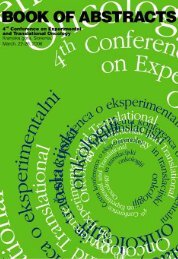Create successful ePaper yourself
Turn your PDF publications into a flip-book with our unique Google optimized e-Paper software.
Sodium iodide method is suitable for DNA isolation from serum <strong>of</strong><br />
colorectal cancer patients<br />
Y. Q. Liu, S. L. Fong, K. W. Eu<br />
Dept. <strong>of</strong> Colorectal Surgery, Singapore General Hospital, Outram Road, Singapore 169608<br />
Tumor-derived DNA has been detected in plasma or serum <strong>of</strong> a variety <strong>of</strong> cancer patients<br />
and may have potential as a tumor marker. A major limitation is that majority <strong>of</strong> these<br />
circulating DNA molecules are small DNA fragments that are usually lost substantially in<br />
the course <strong>of</strong> DNA isolation. Efficient DNA extraction is therefore essential to subsequent<br />
detection <strong>of</strong> tumor markers. In the present study, we isolated DNA in 12 pooled serum<br />
specimens from 52 colorectal cancer patients using 4 isolation approaches. These include<br />
conventional Phenol-chlor<strong>of</strong>orm method, commercial ZR serum DNA kit, sodium iodide<br />
method and widely used QIAamp blood Midi kit. DNA yield was calculated based on<br />
quantification by Quant-iT dsDNA High-sensitivity assay. Purity <strong>of</strong> isolated DNA was<br />
assessed using Taqman real time PCR technique with E-cadherin gene as the target gene.<br />
Quality <strong>of</strong> isolated DNA was further evaluated by analysis <strong>of</strong> bisulfite conversion <strong>of</strong> DNA<br />
isolated by two most productive isolation protocols. Bisulfite conversion was assessed by<br />
real time PCR on a fragment devoid <strong>of</strong> CpG site <strong>of</strong> β-actin gene. Although DNA yield was<br />
not performed in QIAamp blood Midi kit-isolated DNA due to utility <strong>of</strong> carrier nucleic<br />
acid, phenol-chlor<strong>of</strong>orm method and sodium iodide method produced significantly<br />
higher DNA yield compared to ZR method (Mean, 486.72 ng/ml; 361.3172 ng/ml;<br />
24.32 ng/ml, respectively, P < 0.05 after Bonferroni correction). Interestingly, the sodium<br />
iodide method generated the highest level <strong>of</strong> E-cadherin gene copies among 4 protocols<br />
tested. It also outperformed the phenol-chlor<strong>of</strong>orm method in the bisulfite conversion<br />
efficiency. In addition, the sodium iodide procedure is simple, rapid and non-costly. Our<br />
data clearly demonstrated that the sodium iodide method seems to be a suitable method<br />
for circulating<br />
p26<br />
DNA extraction in cancer biomarker study.<br />
108
















